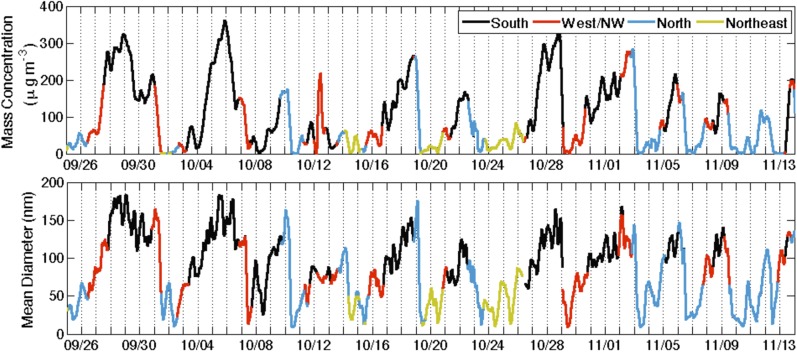Contrary to the finding by Guo et al. (1), Li et al. argue that regional transport of fine particulate matter (PM2.5) represents the major cause for severe haze formation in Beijing (2). We noticed that the letter by Li et al. contains numerous nonscientific and unsubstantiated arguments: for example, “Guo et al.’s conclusion…goes against a broadly held view” and “Our [Li et al.’s] conclusion…is consistent with…control measures.” The letter by Li et al. hinges on three sentences describing their methodology and results, but provides little detail to assess the validity of their conclusion.
Ideally, regional transport may be evaluated using chemical transport models that interactively consider emissions, chemistry, meteorology, and removal (3, 4). Li et al. (2) take a step backward by adopting an unrealistically simple hybrid receptor modeling approach, and their conclusion is drawn on the basis of a methodology that contains several fundamental flaws. Most noticeably, Li et al.’s analysis ignores PM chemical production and loss processes. The severe haze formation in Beijing is characterized by enormously efficient secondary PM formation (1), and an attempt to evaluate its formation without considering the PM formation inevitably renders untrustworthy results. In addition, severe haze formation significantly influences the development of the atmospheric planetary boundary layer, which subsequently impacts dynamics and vertical transport (5, 6). Furthermore, the back trajectory analysis by Li et al. (2) is unsuitable for urban-scale studies because it employs large-scale wind fields with coarse resolutions and does not consider the complex urban canopies.
There are additional technical errors in the letter by Li et al. (2). Their statement that “Temporal evolution of PM2.5 in Beijing…” contradicts the simultaneous occurrence of rapid PM formation between Beijing and Baoding on September 27, 2013. Li et al.’s view on “APEC blue” ignores the fact that traffic emissions in Beijing could also be considerably reduced. Furthermore, the authors fail to comprehend several crucial lines of evidence by Guo et al. (1), implicating efficient local PM production in Beijing and eliminating the cause of regional PM transport. For example, the most rapid PM size and mass growths coincided with elevated daytime ozone levels, reflecting efficient photochemical activity during rapid haze formation. The secondary aerosol constituents (with the mass fractions of 44% for organics and 22% for nitrate) dominated and occurred concurrently with high concentrations of aromatic volatile organic compounds (VOCs) and nitrogen oxides (NOx), further supporting the importance of urban-scale photochemical production from traffic emissions. Furthermore, the polluted periods in Beijing typically corresponded to stagnant conditions, with weak and variable winds (Fig. 1), but not consistently from the southern region. Most evidently, a daily increase of more than 200 μg/m3 in the PM2.5 mass concentration occurred on September 27, 2013, when the wind was initially westerly/northwesterly. In summary, in situ measurements of the PM properties and gaseous precursors by Guo et al. (1) provide the compelling evidence that photochemical oxidation of VOCs and NOx from urban traffic emissions and sulfur dioxide (SO2) from regional industrial sources is primarily responsible for the severe PM2.5 events in Beijing, and the claim of significant regional transport by Li et al. (2) using an unrealistically simple approach is unreliable.
Fig. 1.
Temporal evolutions of PM2.5 mass concentration (Upper) and mean diameter (Lower) during the polluted events from September 25 through November 14, 2013 in Beijing. The colors represent the air mass originating from the south (black), west or northwest (red), and northeast (yellow).
Footnotes
The authors declare no conflict of interest.
References
- 1.Guo S, et al. Elucidating severe urban haze formation in China. Proc Natl Acad Sci USA. 2014;111(49):17373–17378. doi: 10.1073/pnas.1419604111. [DOI] [PMC free article] [PubMed] [Google Scholar]
- 2.Li P, et al. Reinstate regional transport of PM2.5 as a major cause of severe haze in Beijing. Proc Natl Acad Sci USA. 2015;112:E2739–E2740. doi: 10.1073/pnas.1502596112. [DOI] [PMC free article] [PubMed] [Google Scholar]
- 3.Fan J, et al. Simulations of fine particulate matter (PM2.5) in Houston, Texas. J Geophys Res. 2005;110(D16):D16203. [Google Scholar]
- 4.Zhang R, Khalizov A, Wang L, Hu M, Xu W. Nucleation and growth of nanoparticles in the atmosphere. Chem Rev. 2012;112(3):1957–2011. doi: 10.1021/cr2001756. [DOI] [PubMed] [Google Scholar]
- 5.Wang Y, et al. Light absorbing aerosols and their atmospheric impacts. Atmos Environ. 2013;81:713–715. [Google Scholar]
- 6.Fan F, Zhang R, Tao WK, Mohr K. Effects of aerosol optical properties on deep convective clouds and radiative forcing. J Geophys Res. 2008;113(D8):D08209. [Google Scholar]



